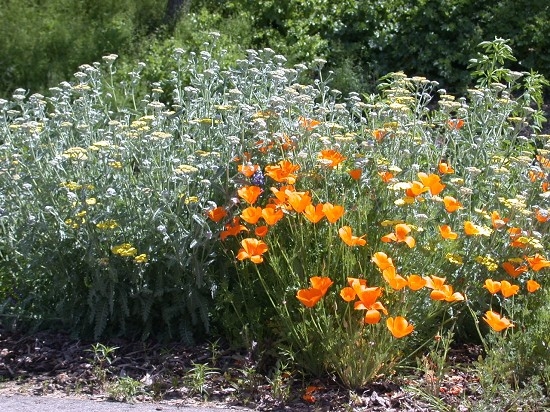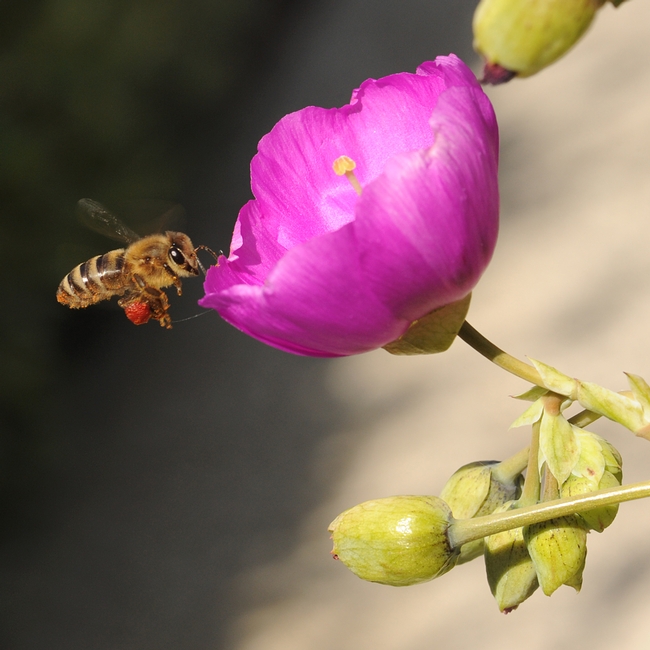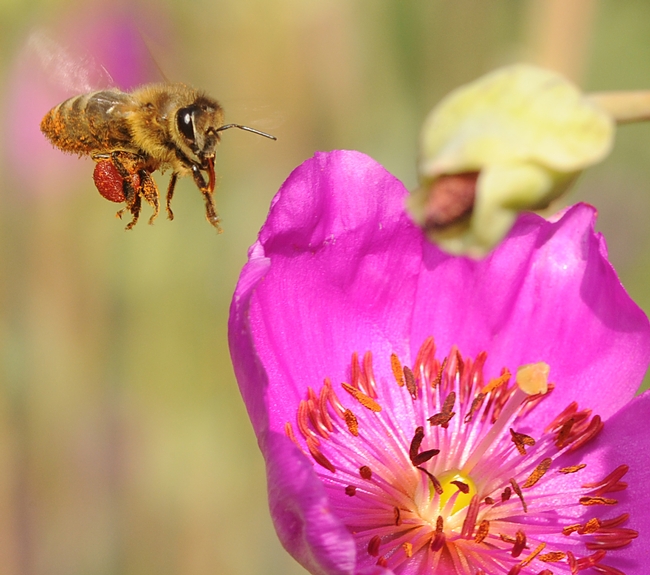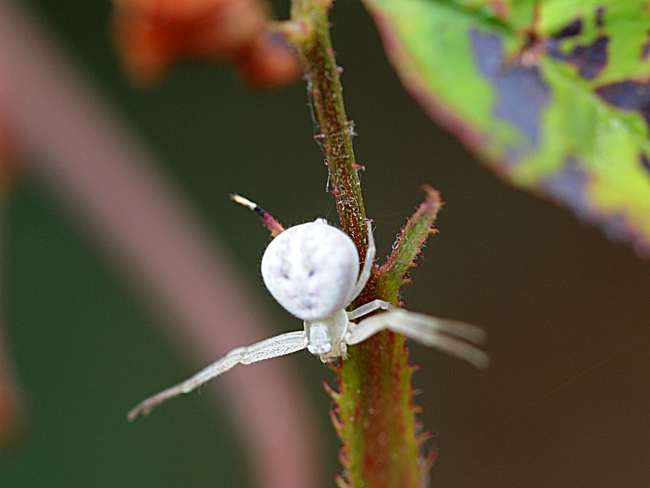From the UC Blogosphere...
How to Plan a New Garden
My Master Gardener friends call me a nursery junkie. I have trouble passing by a nursery without stopping to see what they have. I love to search for new and exciting plants or for better versions of those I already have.
If you are planning a new garden, you have some decisions to make before you head for the nursery.
Are you planting a perennial garden for the long term, or do you want a colorful, showy garden for the current growing season? How much sun or shade does your garden receive? The amount of sun can be different in summer and winter due to the changing angle of the sun’s rays, an important consideration when siting perennials. If your garden has no buildings or trees near it, it will have exposure to sun year around.
Make sure you have good soil for your plants, whether you are planting in the ground or in pots. Soil is your foundation. It consists not only of solid materials, including a mixture of clay and sand, but also loose organic matter that allows space for the water and air that plant roots need.
Once you’ve fulfilled those requirements, it’s time to decide what to plant. Do you want a more formal garden in the English style, with plants organized in groupings and arranged by colors within distinct borders? Or would you rather have a more natural garden, with a lot of different plants blending in more of a rambling fashion?
Once you have a plan, you’re ready to head off to the nursery (or nurseries). You don’t have to have specific plants in mind at this point. You just need an understanding of your planting site and an idea of what effect you want your garden to have when it develops.
Walk up and down the aisles of the nursery, looking at what’s available. Check the tags on the plants you like to see whether they need sun or shade, whether they are short at maturity or 10 feet tall. Width at maturity is also important in determining how far apart you should space plants if you’re putting in more than one of the same kind.
Do seek the advice of nursery sales staff. Tell them the details of your garden location and the effect you’re seeking. But resist the impulse to purchase at this point. You’re just getting ideas. Visit several nurseries, making notes on the plants you like.
Lastly, once you have your plan, return to the nurseries to see which ones have the best examples of the plants you seek. Stock can vary considerably from week to week. One nursery might have a variety of healthy azaleas this week but minimal inventory next week. Remember that most nurseries don’t grow their own stock. They get new deliveries from suppliers regularly.
If you take the time to do this type of planning and shopping, you will be greatly rewarded as your plants grow and produce the kind of garden you had hoped for. Designing a garden is a lot like painting a picture. You start with a plan, choose your palette, and then begin to paint, watching your creation evolve as you work.
Putting Lettuce in the Tulips
Why do we hide edible plants in our gardens? Who says they aren’t beautiful? Many contemporary gardeners are welcoming the diversity of textures and colors that edible shrubs and trees give to their surroundings.
There are also some practical reasons for mixing fruits and vegetables with ornamental plants. Flowering plants attract pollinating and beneficial insects. So interspersing food crops among plants such as lavender, butterfly bush and clematis that draw bees and butterflies can mean a larger harvest.
Growing fruits and vegetables that are not available at your grocery store is an easy way to stretch your food budget while adding variety to your menu. And you don’t need a big garden to make this happen. The Napa County Master Gardener Garden Tour on Sunday, May 15, features a wonderful small cottage garden with edible plants growing street side among ornamentals. Salad makings such as spinach and pansies are tucked into the colorful landscape. Fig trees provide shade as well as a late summer harvest.
Tuck a couple of fruit trees into your yard; a dwarf fruit tree is an excellent focal point. Asparagus plants can create a lovely feathery divider after harvest. Grapevines can cover an arbor as easily as roses. A low hedge of blueberry bushes provides spring flowers and fall color along with the nutritious fruit. Strawberries, thyme and oregano all make excellent ground covers. Creating a salad border along the edges of raised beds with lettuces, chives (their pale purple blossoms are tasty, too), green onions, pansies and parsley. Put taller plants such as dill, fennel, peas, corn and beans in the back of beds or center them in containers.
Marion Owen, co-author of “Chicken Soup for the Gardener’s Soul,” suggests several appealing plant combinations, including curly parsley with yellow pansies; red leaf lettuce with yellow and orange calendulas; red chard and New Zealand spinach; dwarf curly kale with dusty miller, aromatic pink nemesia, and dianthus; oregano with red chard and trailing white lobelia; or parsley and strawberries with trailing blue lobelia.
Consider your site carefully because most edible plants require at least six hours of sun each day. However, leafy salad greens with a short growing season do well in shady conditions. In areas of your garden that are hard to water, plant drought-tolerant herbs such as rosemary. The hardy bush form has pretty blue blossoms.
Evaluate the ornamental features of the edibles you’re considering. What color are the fruits, flowers and foliage? Think about shapes, too. Is the plant tall and spiky, round and full, or cascading? Use edibles as visual complements in your garden. For example, a green border might benefit from the bright color of peppers. Globe artichoke plants have a striking architectural form and such gorgeous purple flowers that it’s hard to decide whether to eat the artichokes or let them bloom. Garlic, onions and sunflowers all have showy tops, too.
Don’t forget containers. How about a pot of cherry tomatoes, geraniums and basil? Lettuce and tulips are a classic spring combination. For beauty and utility, edibles are welcome additions to the ornamental garden.
Mariposa gardener inspires story about UCCE program
The Mariposa County UC Cooperative Extension Master Gardener program got a shot in the arm Saturday when the Merced Sun-Star ran a lengthy feature about the extensive gardens of one of the program's 50 volunteers, Elna Philbert.
Philbert's one-acre "Tannenbaum Forest" got its start 22 years ago with a Colorado blue spruce she received in memory of her late husband, the article said. Each year since, she purchased a living Christmas tree and planted it in the yard.
In time, the retired teacher added a Japanese maple grotto, grasslands, a presidential rose garden and a 49er corner, decorated with rusted shovels, buckets and gold pans she found on her property. Philbert told reporter Debbie Croft the garden is her pride and joy.
The article went on to describe the active Mariposa County Master Gardener program, noting that Mariposa volunteers have contributed more than 25,000 hours since 1995 to extend gardening information to their neighbors. The group helped start Merced's Master Gardener program three years ago. Five recent graduates received their certification, bringing Merced's total to 42, with more than 3,000 hours of service completed.
"We don't solve everyone's gardening problems," the story quoted Master Gardener Betty Johnson. "We assist county farm advisers by providing research-based information to the community."

Yarrow and California poppies growing in the Mariposa MG demonstration garden.
Red-Eye Flight?
Unlike airplane pilots, honey bees don't file a flight plan.They know where they're going because their sisters tell them...

Pollen-packing honey bee heading toward a rock purslane. (Photo by Kathy Keatley Garvey)

Cleaning her tongue as she flies, a honey bee is on a mission: rock purslane. (Photo by Kathy Keatley Garvey)
Not a Good Day for a Flower Fly
It was not a good day for a flower fly.A flower fly, aka syrphid fly, dropped down in a patch of pink roses at...

Crab spider nails a flower fly in the Haagen-Dazs Honey Bee Haven. (Photo by Kathy Keatley Garvey)

Crab spider loses its prey and heads down a stem. (Photo by Kathy Keatley Garvey)







